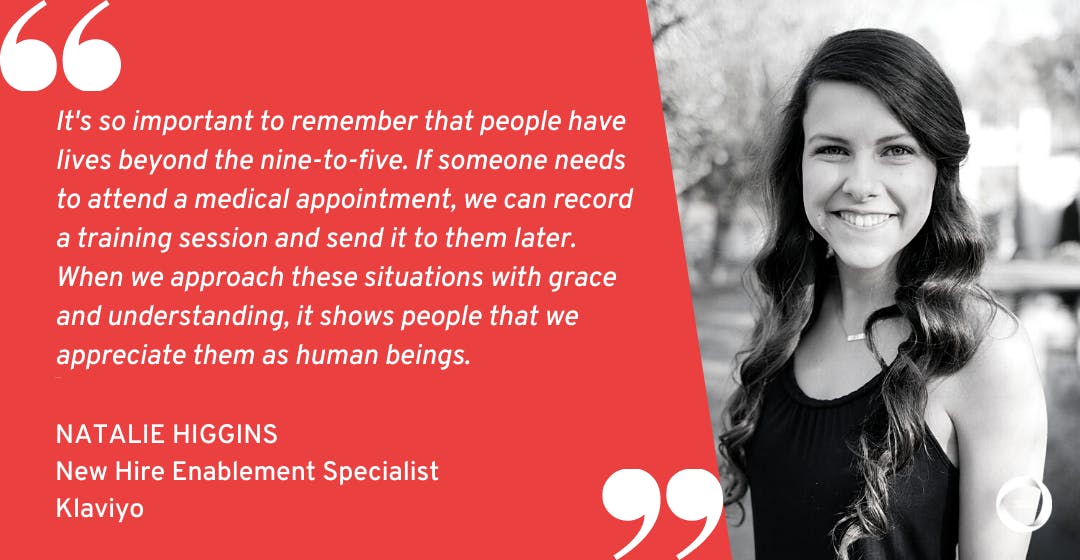Like a lot of companies around the world, 360Learning is growing like crazy right now. Every week, we have new people joining us from all over the world. It’s my job to make sure every single person feels welcomed, valued, and connected to their new colleagues.
This isn’t always so easy–especially when working remotely. We need to constantly be on the lookout for ways to improve our systems and deliver great experiences for our new hires.
That’s why it was so great to sit down with Natalie Higgins, New Hire Enablement Specialist at email marketing platform Klaviyo. We spoke about the 3 steps she uses to drive a NPS of 85% and over, and how she uses Collaborative Learning in action.
To kick things off, Natalie told me about the challenges of scaling new hire enablement during the COVID-19 pandemic.
The challenges of scaling new hire enablement during COVID-19
As Natalie explains, Klaviyo is growing. And like a lot of companies growing in the midst of the current global health crisis, this growth gives rise to some unique scaling challenges.
“For anyone who doesn’t know, Klaviyo is in a period of rapid-intensity growth right now,” she says. “We’ve just had a ton of people join, and a ton of new customers too, mostly during 2020.”
“Like everyone else, when the pandemic hit, we had to adjust to working from home and relying on virtual interactions. We need to make sure we’re providing the same experiences to our ‘new Klaviyos’ as they would have had in an office. By helping them understand our company values and our culture, we help them to see how they bring value to the organization.”
For Natalie, this remote onboarding process takes preparation, collaboration, and above all else, flexibility. “It’s so important to remember that people have lives beyond just the nine-to-five, and we may not always know what is happening with them.”
“If I can provide them with a bit more flexibility with their training program, this can have a huge impact. It helps people to feel more comfortable and relaxed, and to make them feel like they made the right decision coming to work with us. For example, if someone needs to attend a medical appointment, we can record a training session and send it to them later.”
“When we approach these situations with grace and understanding, it shows people that we appreciate them as human beings.”
So, how does this flexibility work in practice? For Natalie and Klaviyo, it’s all about welcoming new hires with tailored onboarding.

Related: The 360Learning Onboarding Playbook
Base Camp, product training, and Boot Camp: how Klaviyo welcomes new hires
As Natalie explains, Klaviyo has committed to a thorough process for onboarding new hires.
“In terms of our structure, we have what many people would consider to be a long onboarding process,” she says. “This is to give everyone a really strong understanding of the information they need to eventually succeed in their roles.”
First up is their new hire ‘Base Camp’.
1. New hire Base Camp
“At Klaviyo, we start out with a one-week session called our ‘Base Camp’,” says Natalie. “This involves learning everything about the company our new people need to know for their role: our values, our culture, and our customers. This helps everyone to be on an even playing field to move into the next step: dedicated product training.”
2. Dedicated product training
“After Base Camp, the next step for our customer and product-facing roles is to progress to product training. Here, our new hires take a deep-dive into the Klaviyo platform. They get to understand the features we provide to our customers, how our customers use these features, and why they’re leveraging Klaviyo over a different platform.”
According to Natalie, this dedicated training helps new hires to understand every step of the customer journey. “We really want people to understand what that customer journey looks like, and why our customers are utilizing the features they’re utilizing. Our new hires need a deep understanding of how our platform operates, and how our customers can leverage it.”
3. Role-specific Boot Camps
With Base Camp and product training done, it’s time for the next stage of Klaviyo’s new hire enablement: role-specific onboarding.
“After these first two weeks, our new people will step into role-specific ‘Boot Camps’, as we like to call them,’ says Natalie. “These are run by their individual teams, and they’re designed to guide the new hires through everything they need to know about their full-time roles.”
We really want people to understand what that customer journey looks like, and why our customers are utilizing the features they’re utilizing. Our new hires need a deep understanding of how our platform operates, and how our customers can leverage it.
Need a few more CLO Connect expert insights? Find out How L&D Can Help Your Company Scale
Klaviyo’s 3 steps to put Collaborative Learning to work in new hire enablement
Within this thorough process of new hire enablement, Natalie uses three key steps to putting Collaborative Learning to work. As she explains, it starts with a focus on social learning.
“We build a strong collaborative and social learning component into our new hire onboarding. If you’ve heard of the 70-20-10 model, that 20% is our social learning component. We’ve done a few different things here, both during Base Camp and in our product training.”
First up: Klaviyo’s collaborative ‘pitch projects’.
1. Collaborative pitch projects
“One of my favorite Collaborative Learning initiatives is what we call our ‘pitch project’,” says Natalie. “This is where we assign our Base Camp cohort members into small groups, and they create a two-minute video answering the question, ‘what is Klaviyo?’”
“This is a really fun exercise, because it’s a little more playful. It really helps our new hires to focus on the core questions of who we are, what we do, who we serve, and some of the things that set us apart from our competition. It’s a really good way for them to dig deeper.”
And speaking of digging...
2. The Klaviyo culture dig
“We also have another initiative called the ‘culture dig’, which is halfway through our first week of onboarding,” says Natalie. “This involves people working together to examine what makes up the Klaviyo culture, and what we really want to maintain as we continue growing.”
“What are the values that are guiding us, and how are we making decisions based on these values? Working on these questions as a team really helps people to engage with our culture.”
3. Watching crowdsourced customer videos
“My final favorite one is called ‘meet the creators’. This is a session where our new hires watch short videos submitted by our customers. They get to hear about how our customers found Klaviyo, how they’re using the platform, and what they’d love to see from us in the future.”
As Natalie explains, these three Collaborative Learning exercises help to reinforce the concept of company culture as a living and breathing thing. “Our training impresses upon our new hires the idea that we’re never satisfied with where we are, and we’re always going to look for ways to improve our platform based on suggestions and requests from our customers.”
“This helps to create the mindset early on that we love our platform, we want to continue to make it better, and we’re working with our customers to make sure that happens.”
Related: How Toppers Pizza Drove a 40% Increase in Employee Engagement Through Crowdsourcing Videos
Our training impresses upon our new hires the idea that we’re never satisfied with where we are, and we’re always going to look for ways to improve our platform based on suggestions and requests from our customers.
Measuring impact through NPS surveys
So, that’s an overview of Klaviyo’s three key steps for using Collaborative Learning to drive great onboarding and new hire enablement. But how does Natalie ensure her Collaborative Learning techniques are achieving the right outcomes?
“One of the best ways we’re measuring our impact is through our net promoter score,” says Natalie. “We look at whether people are willing to recommend our program to a friend or a colleague, and the score they give the program on a scale from one to ten.”
“We’ve achieved some strong results in the past, including achieving a record score of 100 for one of our training weeks. This was a magnificent time for me, and I was very pleased. We have a rolling score throughout the year, and this is sitting at 85 out of 100 right now. I set a personal goal to maintain this score of 85, and to improve the program based on our feedback.”
“We also include a few questions within our final survey, which asks our new hires to rate how well they understand Klaviyo’s history, our mission, and our internal culture. We also ask people whether they know where to find information, and who they can ask for help.”
“Right now, 96% of our participants agree that they understand these different qualities. This tells us we’re doing really well, but we still have a handful of people who may be struggling. We’re always adjusting our content and our delivery to make sure we improve over time.”
Related: 3 Data-Based Ways to Provide Training ROI (+ Free Training ROI Calculator)
We’ve achieved some strong results in the past, including achieving a record score of 100 for one of our training weeks. This was a magnificent time for me, and I was very pleased.
Thanks again to Natalie for taking the time to share her insights and experiences!
While you’re here, check out my expert interviews with Ta Lynn Mitchell of Code Nation on how to support volunteer coding teachers with Collaborative Learning, and with Emma Schain of Better.com about scaling onboarding from 350 to 3,000 employees.
Want more peer insights on transforming workplace learning? Check out #CLOConnect, our interview series with top L&D leaders on driving growth and scaling culture through Collaborative Learning. Or you can subscribe (below 👇) to our weekly newsletter to receive our latest posts directly in your inbox.



